Chest Home Workout: Sculpt Your Upper Body Without Equipment and Boost Results With Keto Tips
This post may contain affiliate links. If you purchase through these links, I may earn a small commission at no extra cost to you. LEARN MORE.
Getting a strong, defined chest doesn’t have to require a gym membership or fancy equipment.
With just bodyweight exercises done at home and the right diet, anyone can build and shape their upper body.
Combining a chest workout routine with keto nutrition can speed up fat loss and reveal muscle definition.
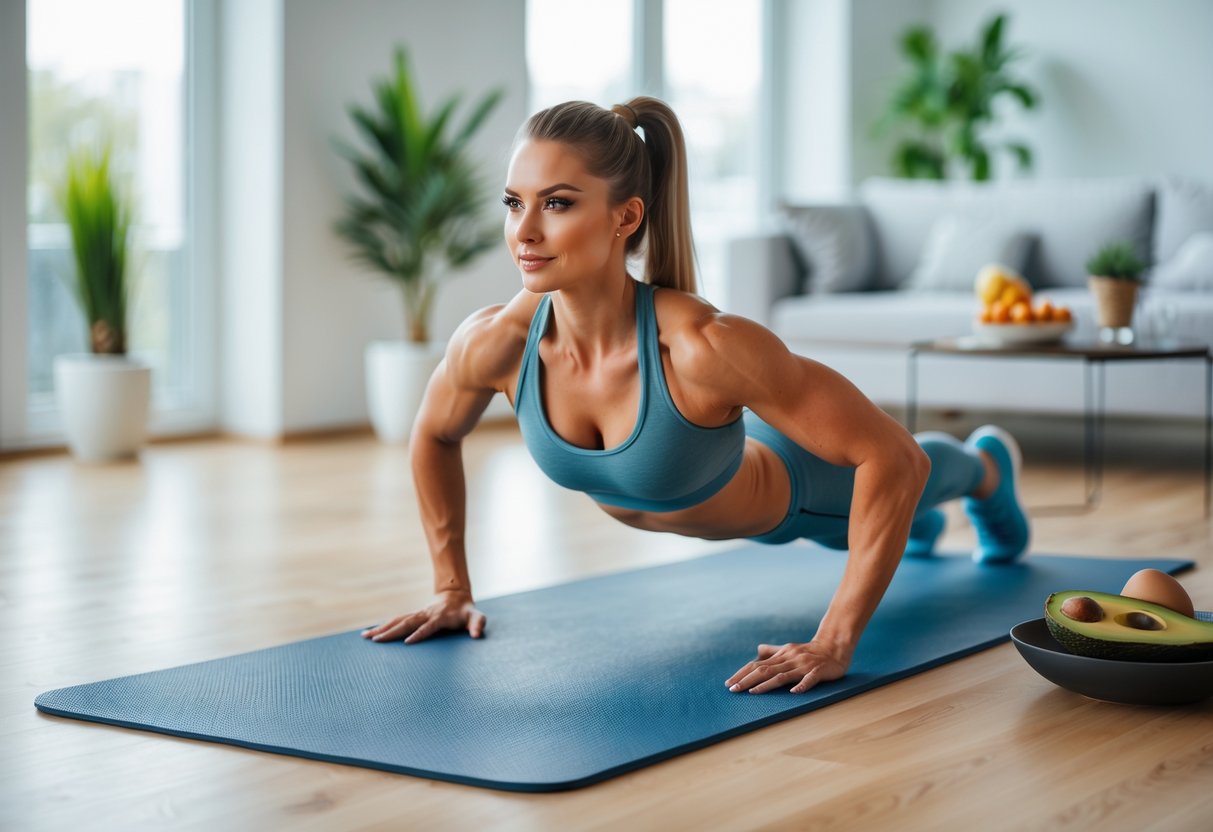
Focusing on targeted exercises, proper form, and consistent effort is key to seeing results.
Keto tips can help manage body fat while supporting energy levels for intense home workouts.
If you’re just starting out, our keto workout guide for beginners is a great place to begin.
Want a fat-burning diet that complements your home training? Try this Custom Keto Diet Plan made just for your body goals.
Key Takeaways
- Chest home workouts without equipment can be highly effective.
- Good form and a smart routine help maximize muscle growth.
- Keto nutrition supports faster fat loss and energy for workouts.
Understanding Chest Anatomy for Effective Home Workouts
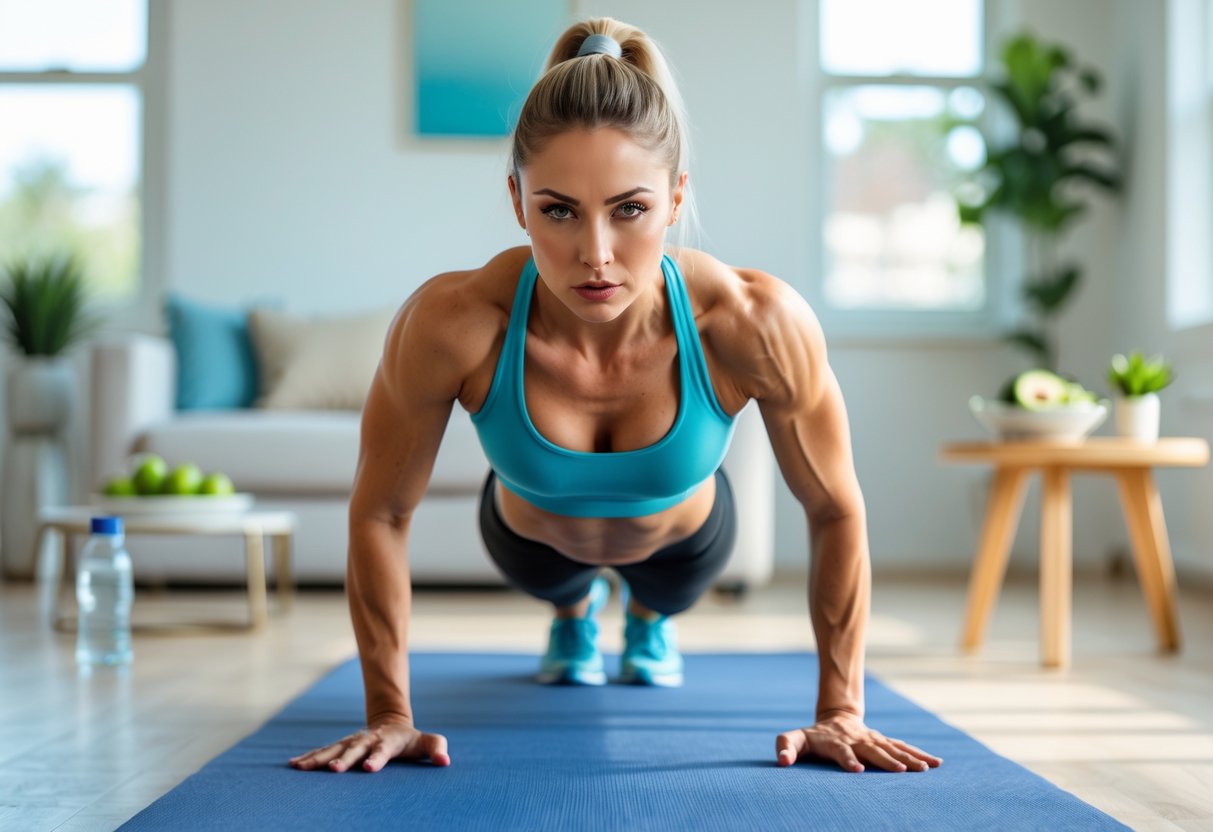
Chest home workout can work well when someone understands which muscles are being used and how to target them.
Proper knowledge of chest anatomy helps a person choose the right exercises and see better results from their routine.
Key Chest Muscles and Their Functions
The chest includes several muscles, but the main ones are the pectoralis major and the pectoralis minor.
- The pectoralis major is a large, fan-shaped muscle that covers most of the chest.
- The pectoralis minor lies beneath the pectoralis major and helps with shoulder movement.
The pectoralis major is responsible for moving the arm across the body, lifting the arm, and rotating the arm inward.
The clavicular head (upper part) of the pectoralis major helps in lifting motions, while the lower part is more involved in bringing the arm down.
Pectoral muscles also play a role in pushing activities, which is why push-ups and similar moves are effective.
Upper Chest vs. Lower Chest: Targeted Activation
The upper chest is mainly made up of the clavicular head of the pectoralis major.
To target this area, one must focus on movements with an upward angle, like incline push-ups or certain floor exercises.
The lower chest focuses more on the sternal head of the pectoralis major.
Exercises that move the arms downward or across the body, like decline push-ups, are best for activating this part.
Proper technique is important since different hand placements and body angles can change which area of the chest is worked the most.
This way, both upper chest activation and lower chest engagement can be controlled during home workouts.
Role of Triceps and Shoulder Joints
The triceps work with the chest muscles during most pushing movements.
While the chest does most of the pushing, the triceps help straighten the arms.
Shoulder joints (especially the deltoid muscles) provide support and stability during chest exercises.
They allow for safe movement and proper range of motion.
It is important not to over-stress the shoulders or triceps.
Doing chest workouts with good form helps protect these areas and reduces the risk of injury.
Training your chest synergistically improves upper body strength, similar to what we discussed in our Strength Training Program for Women.
Essential Bodyweight Chest Exercises Without Equipment
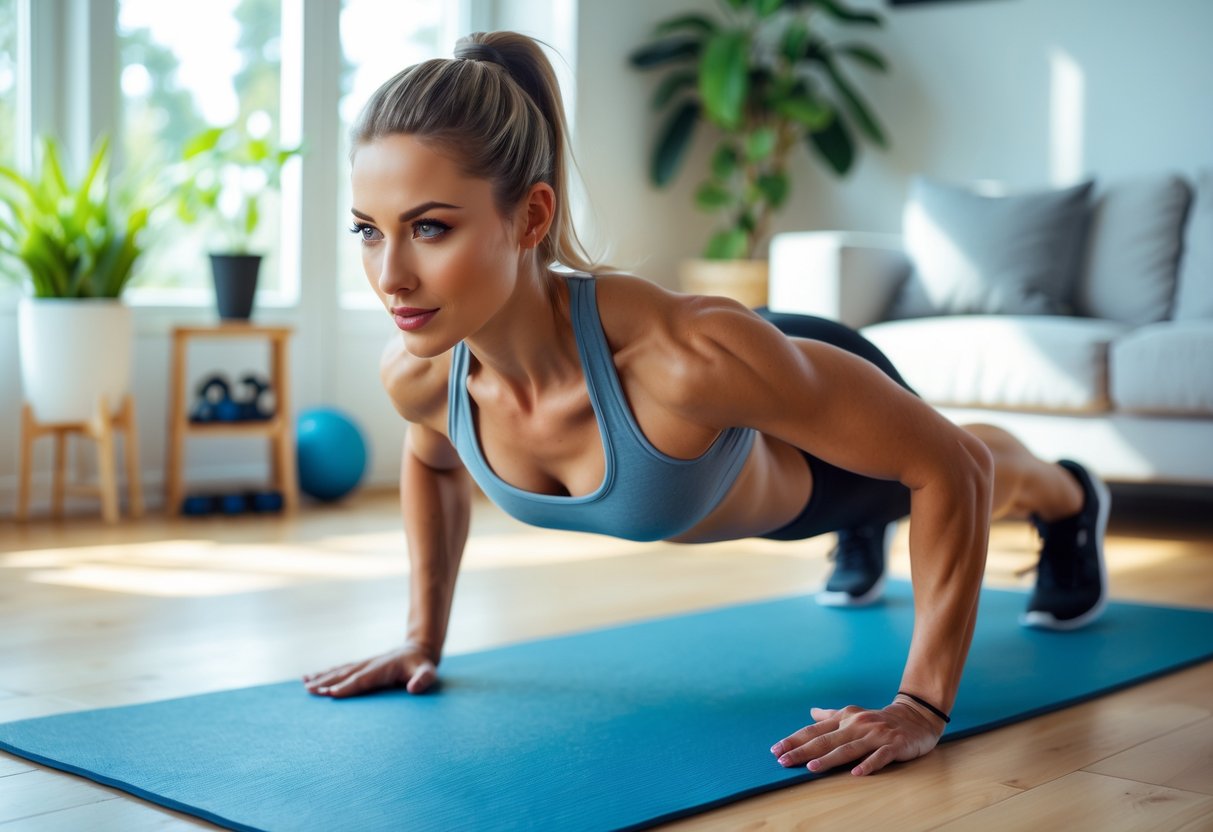
A chest workout at home can be very effective by using only bodyweight exercises.
With simple moves and a focus on proper form, anyone can develop chest strength, shape, and endurance without any special equipment.
Standard Push-Ups and Variations
The standard push-up is the core of many home chest workouts.
It works the chest, shoulders, and triceps, while also strengthening the core.
To do a push-up, hands should be shoulder-width apart and the body kept in a straight line from head to heels.
For best results, use slow and controlled movements to engage the chest muscles.
Beginners may start with knee push-ups until they build up strength for full push-ups.
As strength increases, there are several push-up variations to try, including the diamond push-up and archer push-up.
These variations target the chest differently, providing a balanced upper body workout.
Rotate through different push-up types to keep challenging the muscles and avoid plateaus.
Close-grip push-ups can enhance triceps development and work well in routines discussed in our Home Leg Workout.
Incline and Decline Push-Ups for Targeted Results
Incline and decline push-ups help target different parts of the chest.
Incline push-ups are done with the hands on a raised surface like a bench, sturdy chair, or even stairs.
This move directs focus to the lower chest and is easier than a standard push-up, making it good for beginners.
Decline push-ups require placing the feet on a raised surface and the hands on the floor.
This variation emphasizes the upper chest (pectoralis major, clavicular head) and the shoulders.
Decline push-ups are harder and great for increasing upper chest strength.
Changing the angle of push-ups is important to hit the whole chest and get more from each at-home chest workout.
A simple table can show the differences:
| Variation | Equipment Needed | Main Area Worked |
|---|---|---|
| Incline Push-Up | Chair, Step | Lower Chest |
| Decline Push-Up | Chair, Step | Upper Chest |
Close-Grip and Wide Push-Ups
Changing hand placement changes which muscles do more work.
Close-grip push-ups have hands closer together under the shoulders.
This version places more stress on the triceps and the inner chest.
Diamond push-ups—hands together forming a diamond shape—are a popular form of close-grip push-up.
Wide push-ups have the hands spaced wider than shoulder width.
This position focuses more on the outer chest muscles, stretching the pectorals at the bottom of the movement.
For a stronger and more balanced chest, include both close-grip and wide push-ups during the week.
Form matters: move gently and avoid letting the hips drop or the back sag.
Chest Dips and Plyometric Movements
Chest dips are a challenging exercise that targets the lower chest and triceps.
At home, use sturdy furniture like a pair of parallel chairs or the edge of a low bed.
Sit between the supports, grip the edges, and lower the body while leaning forward.
This forward lean shifts the work to the chest instead of just the triceps.
Plyometric push-ups—such as clap push-ups or explosive push-ups—add a power element.
These boost chest strength and speed.
Lower the body as in a normal push-up, then push up hard so the hands leave the ground.
Plyometric moves are advanced and should be added only after building a solid base with standard push-ups.
They help break through plateaus and increase muscle activation.
For explosive strength, support your energy levels with Nagano Tonic – a natural metabolic booster.
Structuring a Chest Home Workout Routine
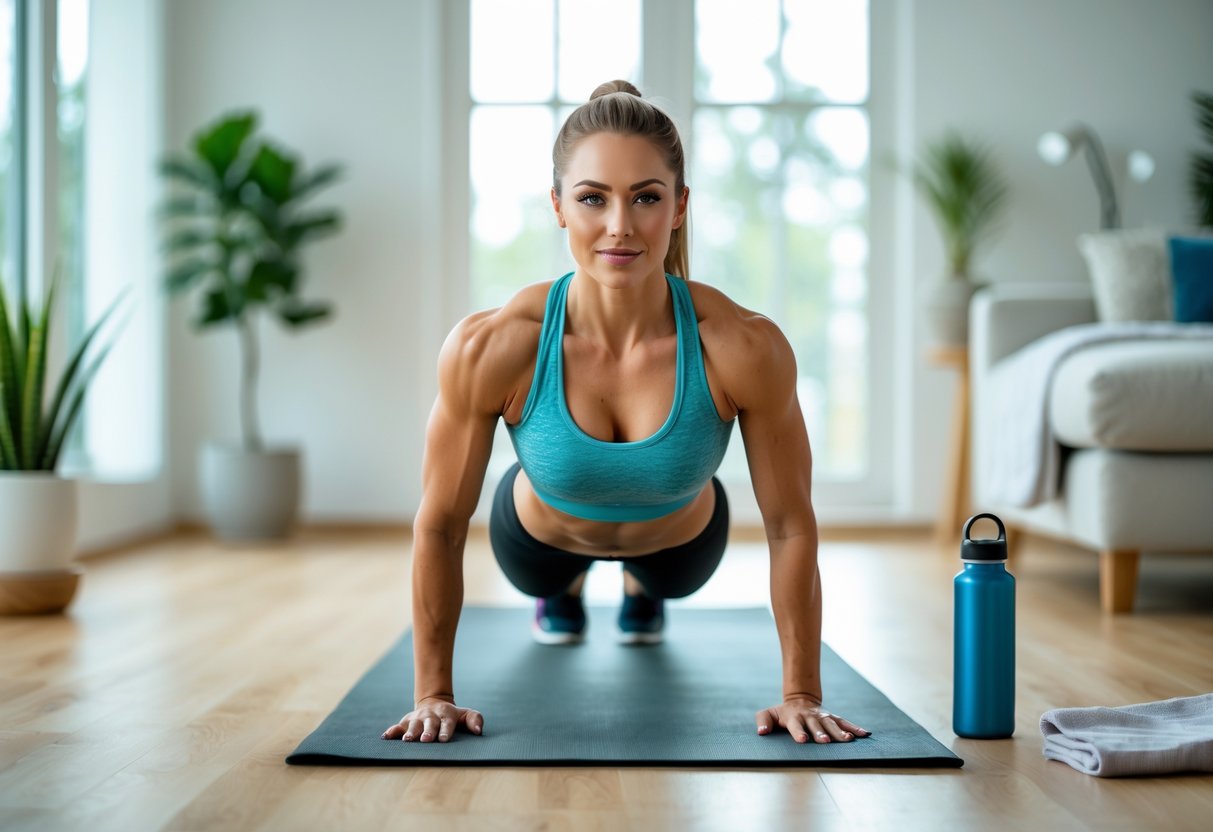
A good chest home workout routine includes the right warm-up, a tailored plan for each experience level, and effective strategies for long-term progress.
Proper rest and recovery are just as important as the exercises themselves for building strength and endurance.
Warm-Up and Mobility Preparation
Before starting any chest workout, a thorough warm-up is key to preventing injury and improving performance.
Five to ten minutes of light cardio, like jogging in place or jumping jacks, increases blood flow.
Follow this with shoulder circles, arm swings, and chest openers to loosen joints and activate the chest and shoulders.
Dynamic stretches, such as arm crosses and wall pushes, help prepare muscles for bodyweight training.
This active preparation boosts flexibility and helps wake up the nervous system.
A well-structured warm-up ensures smoother movement during push-ups, dips, or any other chest-focused exercises at home.
Beginner and Advanced Workout Plans
Beginners should start with a simple routine that builds a solid foundation.
A sample routine might include:
- Standard Push-Ups: 3 sets of 8-12 reps
- Incline Push-Ups (feet on the ground, hands on a raised surface): 3 sets of 8-10 reps
- Wide Push-Ups: 2 sets of 8-10 reps
Take 60 seconds rest between sets for recovery.
Use slower, controlled reps to focus on form.
Advanced lifters can increase intensity and challenge by adding:
- Decline Push-Ups (feet elevated on a chair): 3 sets of 10-15 reps
- Archer Push-Ups: 3 sets of 6-8 reps
- Plyometric Push-Ups: 2 sets of 8-10 reps
Incorporate household items like chairs or sturdy tables for variations such as dips or feet-elevated push-ups to engage the upper chest.
Progressive Overload at Home
Progressive overload means increasing the challenge over time so muscles adapt and grow.
At home, this can be done by:
- Adding more reps or sets each week
- Using slower tempos (pausing at the bottom of each push-up)
- Shortening rest between sets
- Switching to harder variations (like one-arm push-ups or decline push-ups)
Tracking progress in a notebook or phone helps ensure steady improvement.
If bodyweight exercises become easy, try wearing a backpack with books for extra resistance.
Just like in our article on When Keto Diet Starts Working, consistency leads to visible improvements.
Optimizing Rest Days and Recovery
Muscles need time to repair after a workout session.
Schedule chest workouts two or three times a week, leaving at least one full day of rest between sessions.
Active recovery, such as light stretching or mobility work, can help reduce soreness.
Proper sleep and nutrition further speed up muscle recovery and support fat loss, especially important for those following a keto diet.
Signs that more rest is needed include persistent soreness, drops in performance, or trouble sleeping.
Listening to the body and adjusting rest days as needed prevents injuries and promotes steady progress during a home workout plan.
Perfecting Your Technique for Maximum Muscle Growth
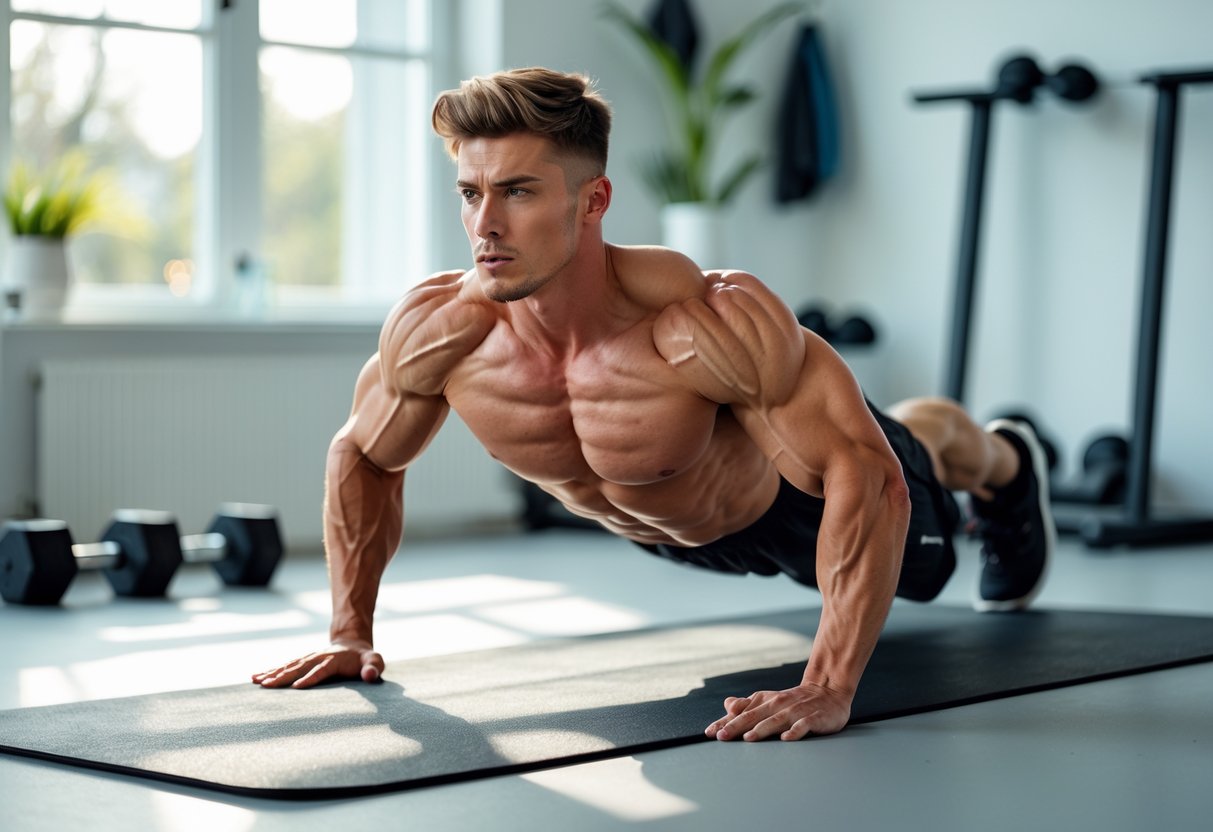
Paying attention to detail leads to better muscle activation and improved chest definition.
Achieving good results at home depends on using correct form, focusing on the chest during every rep, and supporting recovery with stretching and a strong posture.
Proper Form and Hand Positioning
Using proper form is key for every chest exercise. The body should be straight from head to heels during push-ups, with core muscles engaged to support the lower back.
Arms should be at about a 45-degree angle from the torso. This helps protect the shoulders and targets the chest more directly.
Hand positioning changes which part of the chest is worked. A wider hand stance works the outer chest, while a close grip shifts focus to the inner chest and triceps.
For upper chest activation, placing feet on an elevated surface during decline push-ups raises the workload on the clavicular fibers. Those doing sliding flies or similar exercises should focus on slow, controlled movements to fully stretch and contract the pecs.
Enhancing Mind-Muscle Connection
Focusing on the chest muscles while performing each rep helps increase muscle activation and contraction. The mind-muscle connection is the ability to direct attention to the working muscles, instead of letting other muscles take over.
To improve this, slow down reps and pause at the point of peak contraction. Squeeze the chest at the top of every push-up or fly movement and concentrate on feeling the muscle work.
Lightly touching or tapping the chest between sets can also help reinforce this focus. Visualization techniques, such as picturing the muscle fibers contracting, can help keep attention on form.
Ensuring Effective Stretching and Posture
Stretching after workouts helps reduce muscle tightness and supports recovery. Specific static chest stretches, like the doorway stretch, ensure the pecs stay flexible and less prone to injury.
Hold each stretch for 20-30 seconds and avoid bouncing. Good posture during the day supports muscle balance and allows for better range of motion during workouts.
Shoulders should not slouch forward; instead, they should be pulled back and down while standing or sitting. This keeps the chest open and ready for full contractions during exercise.
Reference recovery guidance from Top 10 Muscle Recovery Foods.
Keto Nutrition Tips for Faster Results
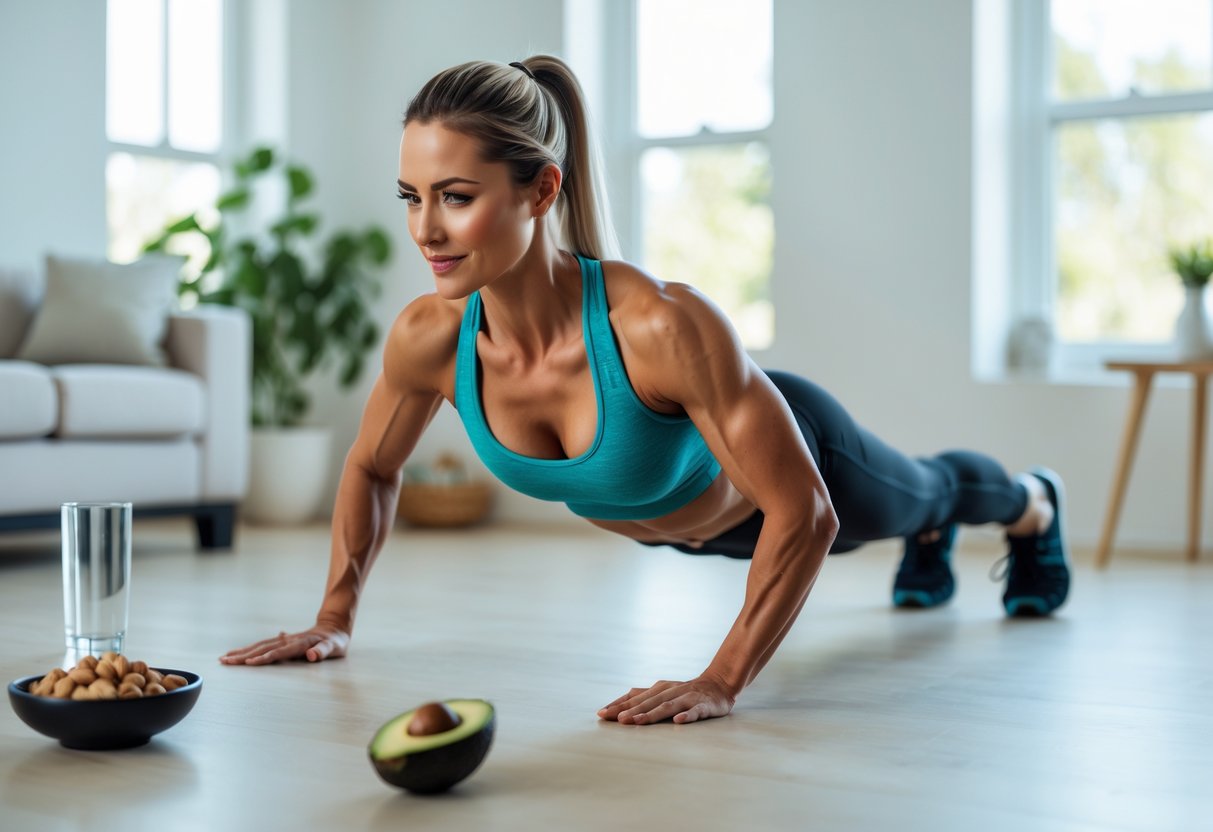
Eating the right foods helps the body burn fat more efficiently when following a keto diet. Proper nutrition, enough protein, hydration, and smart carb choices all make a difference in fat loss and recovery after a workout.
Protein Intake and Keto-Friendly Foods
Eating enough protein on a keto diet is important for muscle growth and repair. Choose high-quality protein sources like eggs, chicken, turkey, fatty fish (like salmon or sardines), and tofu.
Low-carb dairy, such as cheese or Greek yogurt, provides both protein and healthy fats. Nuts and seeds, like almonds or chia seeds, can also be added for extra nutrients.
Here is a quick table of keto-friendly protein options:
| Food | Protein (per serving) | Net Carbs |
|---|---|---|
| Chicken breast | 26g | 0g |
| Eggs | 6g | 0g |
| Greek yogurt | 10g | 4g |
| Tofu | 8g | 2g |
| Salmon | 22g | 0g |
Having protein at each meal helps keep you full, maintain muscle, and reduce cravings. This can support burning chest fat and keeping energy levels up.
Pair your chest routine with Java Burn to enhance metabolism.
Hydration and Recovery On Keto
On keto, water needs often go up because the body loses more fluids from lower carb intake. Drinking enough water stops dehydration, which may cause headaches, fatigue, or muscle cramps.
Adding electrolytes, such as sodium, potassium, and magnesium, helps muscles recover after workouts. Foods like avocado, spinach, and nuts are rich in these minerals.
After exercising, drinking water and eating a salty snack can improve recovery and help the body replace what is lost from sweat. Getting enough sleep also matters since it helps muscle repair and supports metabolism.
Balancing Whole Grains and Low-Carb Eating
Keto limits most grains to keep daily carb intake low. Common whole grains like oats, rice, or bread are usually replaced by low-carb alternatives.
They can eat small amounts of foods like flaxseed or chia, which provide fiber with fewer carbs than regular grains. Focus on non-starchy vegetables—like broccoli, spinach, or zucchini—to add fiber and nutrients without spiking blood sugar.
If extra carbs are needed after very hard workouts, choose the least processed whole grains and control portions carefully. Tracking carbs and sticking to net carbs under the daily limit is key for staying in ketosis and burning chest fat.
Combining workouts with the right protein intake is key – just like outlined in our 7-Day Keto Meal Plan for Beginners
Tracking Progress and Sustaining Motivation
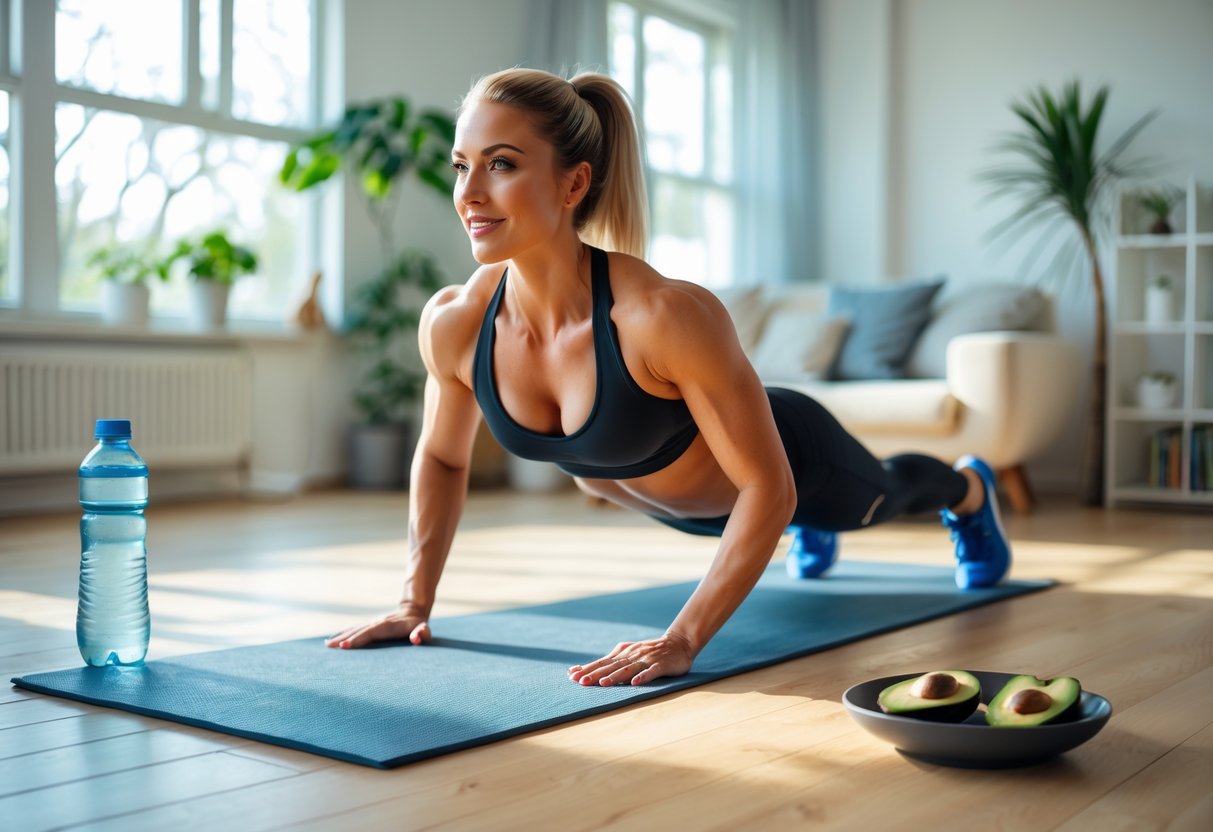
Building chest strength at home is possible with the right plan and mindset. Staying motivated and tracking results helps keep the workout routine effective and enjoyable.
Setting Realistic Fitness Level Goals
Everyone starts at a different fitness level, so it is important to set realistic goals. A beginner may aim to complete a full set of push-ups, while someone more advanced might add new variations like archer or decline push-ups.
Setting small, clear goals breaks the journey into steps that feel doable.
Here are a few examples:
| Fitness Level | Goal Example |
|---|---|
| Beginner | 10 knee push-ups without stopping |
| Intermediate | 20 regular push-ups in proper form |
| Advanced | 10 decline or explosive push-ups |
Tracking these goals in a notebook or fitness app helps keep progress clear. Adjusting goals as strength improves also avoids plateaus.
Refer back to your tips in Exercise and Ketosis.
Measuring Upper Body Strength Development
Measuring strength does not need a gym. Bodyweight exercises offer easy ways to track improvement.
Rep counts, better form, and increased endurance all show progress.
Ways to track upper body strength:
- Count the number of push-ups or dips completed in a row.
- Take weekly photos to notice muscle definition changes.
- Track time held in exercises like plank or wall push-up holds.
Recording these numbers weekly or bi-weekly can show steady improvement. Noticing even small gains keeps motivation high.
Maintaining Long-Term Chest Definition
Consistency is critical for chest definition. Keeping up with regular workouts, even when busy, prevents muscle strength from fading.
Changing up the exercises or rep schemes can reduce boredom and challenge the body. Pair workouts with healthy eating, such as maintaining a keto diet if desired.
Setting reminders and workout schedules can keep routines on track. Staying connected with online communities or friends can offer encouragement and accountability.
Consistency and diet matter – much like what we emphasized in Clean Keto vs Dirty Keto.
Frequently Asked Questions
Exercises at home that use only bodyweight can work the chest and upper body. The keto diet may support fat loss when paired with consistent workouts.
What are effective upper body exercises to perform at home without any equipment?
Push-ups, triceps dips (using a chair), and planks are effective for building upper body strength.
Other moves like inchworms, mountain climbers, and shoulder tap push-ups target multiple muscles.
Different hand positions can help work the chest, shoulders, and arms.
How can I target my upper chest area at home with no weights?
Incline push-ups, where the feet are raised on a step or chair, focus on the upper chest.
Wide push-ups also hit the upper chest and shoulders.
Pike push-ups shift more of the work to the upper chest and shoulders.
What chest exercises are best for beginners looking to work out at home?
Knee push-ups are a good starting point for those who find regular push-ups challenging.
Wall push-ups are even easier and help beginners learn good form.
Negative push-ups, where a slow lowering movement is used, can also build strength safely.
What are some keto diet tips to enhance the results of a chest-focused home workout?
They should focus on eating enough protein to maintain muscle while keeping carbs very low.
Staying hydrated and including healthy fats like avocado and olive oil helps with energy.
Monitoring electrolyte intake is important while on keto, especially when exercising regularly.
How can women tailor chest workouts at home to their fitness levels without using equipment?
Women can adjust the intensity by doing push-ups on knees, against a wall, or with hands on an elevated surface.
Starting slow and increasing sets or reps over time helps prevent injury.
Training 2-3 times a week with rest in between can support strength without overloading the muscles.
Are there any alternatives to push-ups for a chest workout at home that require no equipment?
Chest squeezes, where palms or fists are pressed together in front of the chest, can activate the chest muscles.
Plank-to-push-up transitions and slow-motion arm circles also work the upper body.
Isometric holds, like holding arms out and pushing against an invisible wall, engage the chest without any equipment.
Conclusion
A chest workout at home is possible with simple bodyweight exercises and consistency.
No special equipment is required, so anyone can start right away with what they have.
Proper form is important to prevent injury and get the best results.
Pairing these workouts with a keto diet may help some people reach their goals faster.
Keto can support fat loss and give steady energy for daily routines.
Meal planning and hydration are key for those choosing this diet.
- Keep workouts short but focused.
- Try different push-up variations for full chest engagement.
- Rest between sets to recover.
- Eat enough protein, especially with a keto plan.
- Track progress with a simple chart or diary.
Sample Progress Chart
| Week | Push-Ups (per set) | Keto Meals Tried | Notes |
|---|---|---|---|
| 1 | 10 | 3 | Felt motivated |
| 2 | 15 | 4 | More energy |
| 3 | 18 | 6 | Chest stronger |
| 4 | 20 | 7 | Leaner look |
Ready to see real definition? Start your Custom Keto Diet or boost fat burn with Java Burn and Nagano Tonic today.
